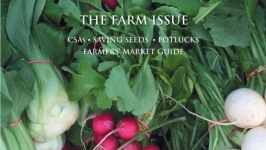First Person: Desperately Seeking Seconds
Most people go to the farmers’ market looking for pristine tomatoes and unblemished peaches. They want produce at the pinnacle of ripeness and beauty. But when I go to the farmstand, I’m looking for something different. I want the imperfect and the slightly marred. I’m there in search of seconds—that’s farmers’ lingo for the produce that isn’t flawless enough to be sold at full price.
I trace my love of scratch-and-dent produce back to my childhood in Portland, Oregon. When I was very young, money was often tight in my family. As a result, we were regulars at our local thrift stores and my mom was forever pulling the car off the road to inspect furniture put out for the trash, to see if it could serve for us. When school snacks or a birthday gift were needed, we’d head for Pic ‘N’ Save, then a large closeout retail chain, for discontinued fruit leather and Barbie dolls two seasons out of date. And during summer and early fall, we’d go on the hunt for untended blackberry brambles and windfall apples for jam and sauce. Thrift was a way of life then—and now it’s a value that doesn’t fade even when I can afford to spend more.
When I moved to Philadelphia and found myself longing to make the preserves of my childhood, I discovered that wild blackberry patches and feral apple trees were much harder to come by around these parts than they’d been on the West Coast. Instead of being discouraged, I kept my eyes peeled for deals on produce.
One Saturday morning eight years ago, I was strolling the Rittenhouse farmers’ market and noticed that one of the vendors had several baskets of tomatoes on their table, set aside from the rest. They were cracked around the stem ends, but otherwise looked perfectly ripe and useable. A small handwritten sign propped nearby read, “Tomato Seconds. $.50 a pound.”
I was unbothered by the imperfections and the price was very right. I started filling a bag. When the farmer came to weigh my selections, he asked what I planned on doing with the fruit. I explained that they were destined for a batch of tomato jam; he mentioned that he often had seconds available for canning. Would I be interested in buying them again? His offer was issued casually, but the prospect of discounted produce made my pulse quicken. I was very interested!
Since then, I’ve chopped, peeled, pitted, pulped, jammed, pickled, and canned my way through many hundreds of pounds of seconds. I’m on friendly terms with farmers and growers from all over Pennsylvania and New Jersey simply by virtue of the fact that I’m interested in their less beautiful—but still perfectly useable and edible—fruit.
What you get when you buy seconds varies a little from farmer to farmer. Perhaps there was a hailstorm when the apricots were small. The pockmarks and blemishes inflicted by the hailstones are there to stay, but the fruit inside is perfectly sweet and good, especially for making jam. Another common occurrence is rain-split fruit. If the cherries or tomatoes are nearly ripe when a soaking rain rolls through, the fruit can’t help but absorb that moisture. All that extra water causes the skin to crack, which can lead to mold and rot if the fruit is left on the tree or vine. So the farmers pick it and hope that canners like me will take a flat or a half-bushel off their hands before it spoils. I’ve found that split cherries make the most delicious sweet cherry butter, and you’d never know that the fruit was anything but perfect.
Often, it can take advance coordination with a farmer via phone, text, or email to get large quantities of seconds. Unless they’re truly desperate to move the produce, growers won’t often bring multiple flats to markets with them for fear that they won’t be able to sell them. I check in with the folks at Beechwood Orchards in Biglerville, Pennsylvania, with a quick email nearly every week during the summer, to see what they have that they need to unload on the cheap. Three Springs Fruit Farm has a retail shop on their website where you can order seconds for pickup at the Sunday Headhouse Square farmers’ market.
And over at Reading Terminal Market, the Fair Food Farmstand also often has canning-worthy produce that they need to get off their hands. Pro tip: If you don’t see anything set out and reduced for quick sale, make sure to ask at the register to see what they have in the downstairs cooler.
Usually, you do have to work quickly when you buy second-quality fruit. More than once, I’ve come home with a flat of strawberry seconds only to discover that the window of time left before they’re going to be unfit for jamming is closing faster than I thought. Make sure to budget an hour for sorting, washing, trimming, peeling, and chopping your bargain produce when you get home. When you get hold of seconds, it’s best to have a plan for how you’ll use them—in the next 12 to 24 hours.
Typically, growers will only sell seconds in larger quantities. However, don’t think that you’re out of the seconds game if you can’t deal with a whole flat or half-bushel on your own. Find yourself a produce buddy to split it, so that you can get the deal and rescue the fruit without overwhelming yourself with 25 pounds of plums.
This summer, make a point of asking your favorite farmers about their seconds. Most will be delighted to sell you their imperfect produce. Over time, you’ll find that you’re not just getting a flat of tomatoes or strawberries out of the deal. You’re also making yourself richer in connections and community, while fighting food waste in the most delicious way.







